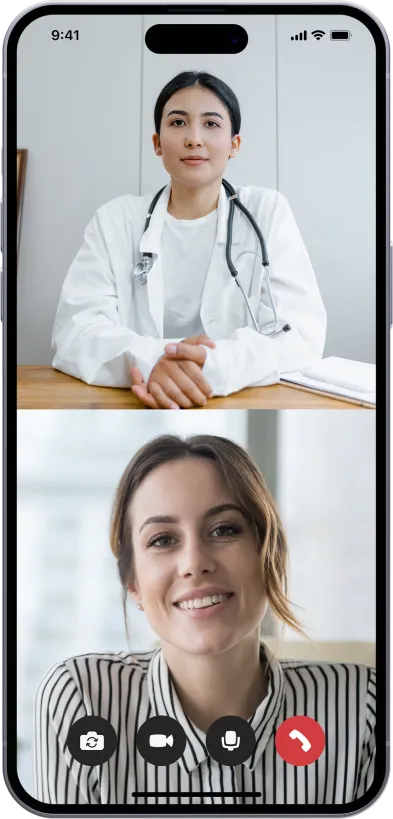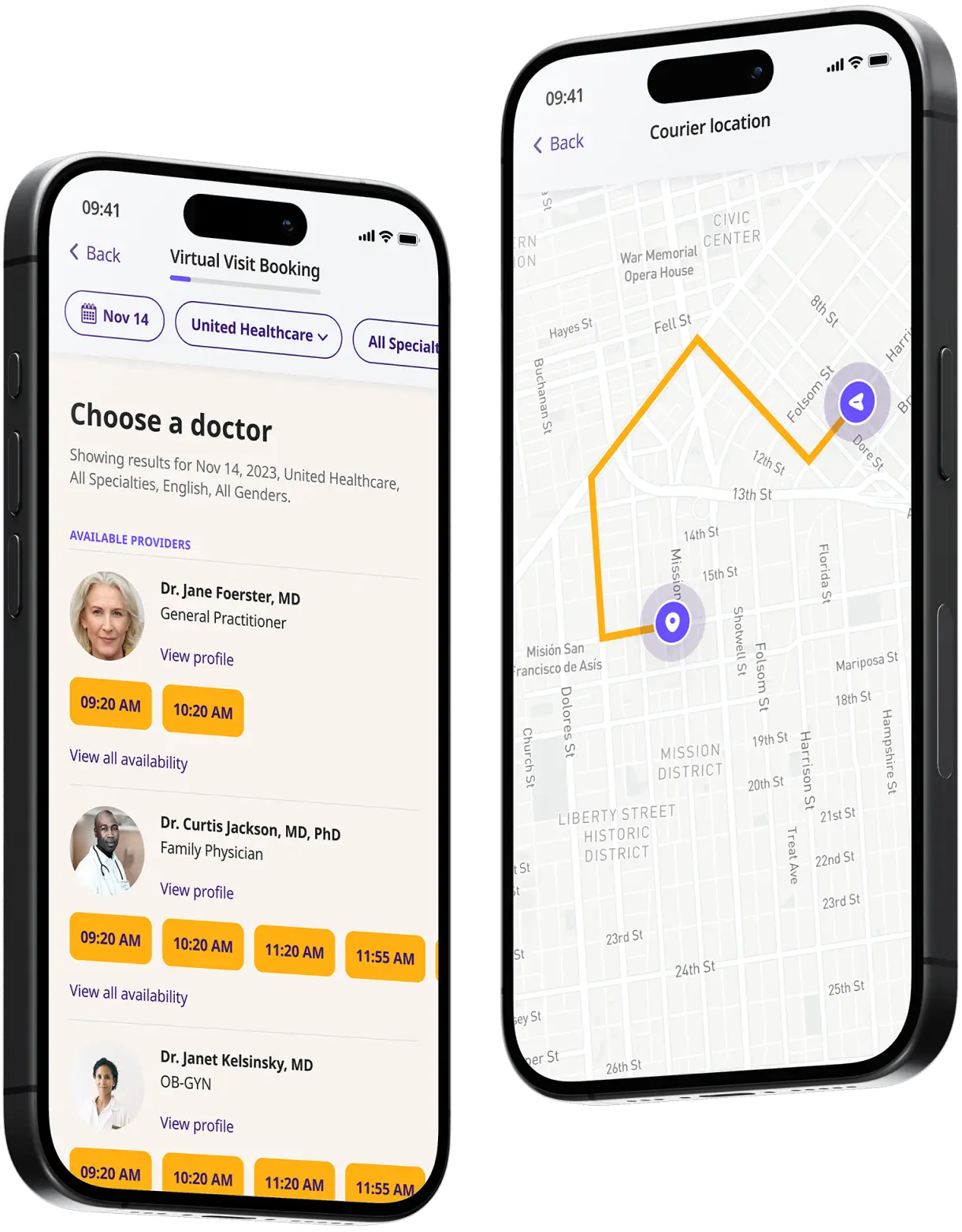Scabies Treatment Online
Treat scabies effectively with help from an online doctor. Get rid of mites and ease itching with fast, expert-guided solutions.


Available in 50 states. Insurance accepted.
Fast
virtual visits
24/7 care
assistants
Prescriptions
as needed

24/7 Personal Care
Consult with a physician in 15 minutes, refill an Rx or chat with our care assistants.

Affordable & Convenient
See your cost upfront and get treatment for hundreds of different conditions.

Insurance Accepted
We accept most major insurance plans, making healthcare easy and affordable.
See If Delivery Is Available Near You
Delivery Not Available
Enter your ZIP code to check if prescription delivery is available in your area and how soon your meds could arrive.
How to get started
Choose your doctor, start a virtual visit, and have your prescriptions sent to your preferred pharmacy for pickup — all in just a few easy steps.
Choose a doctor
Choose a physician by availability, specialty, ratings, and more.

Start your video visit
Connect with a doctor in minutes on a secure video call.

Get your prescription
Pick up your meds or have them delivered in as little as an hour.

Available in 50 states. Insurance accepted.
One-Time
Physician Visit
One-time visit with a physician for diagnosis, treatment, Rx, labs, referrals, and doctor’s notes.
Accepted Insurances
See why people turn to DrHouse...
As seen in

Scabies Treatment Online
About scabies
Scabies is a highly contagious skin condition caused by a tiny mite known as Sarcoptes scabiei. These mites burrow into the skin, causing intense itching and a pimple-like rash.
The condition spreads through direct skin-to-skin contact with an infected person, or less commonly, by sharing clothing, bedding, or towels.
Scabies can affect anyone, regardless of personal hygiene, though it is more common in crowded living conditions where close body contact is unavoidable. It is also seen frequently in nursing homes, childcare facilities, and dormitories.
The life cycle of the scabies mite begins when the female mite burrows into the skin to lay eggs. These eggs hatch into larvae, which then mature into adult mites.
The presence of the mites and their eggs causes allergic reactions in the host’s skin, leading to severe itching and discomfort, particularly at night.
Diagnosis of scabies typically involves the identification of mites, eggs, or fecal matter (scybala) in skin scrapings viewed under a microscope.
Treatment generally involves prescribed medicated creams and lotions to eliminate the mites, and thorough cleaning of all clothes, bedding, and towels used by the affected individual to prevent re-infection.
What causes scabies?
Scabies is caused by an infestation of the skin by the human itch mite called Sarcoptes scabiei var. hominis. This tiny, microscopic mite can only complete its life cycle on humans.
Scabies is transmitted through prolonged skin-to-skin contact with an infected individual, making it highly contagious in close-living conditions.
The scabies mite typically enters the skin through areas where the skin is thin and soft, such as between the fingers, around the wrists, elbows, or buttocks. Once on the skin, the female mite burrows into the skin to lay eggs.
This process is often undetectable at the outset, and symptoms can take as long as four to six weeks to appear in individuals who have never had scabies before. For those who have had scabies previously, symptoms may appear much sooner due to sensitization of the immune system.
The primary driver behind the spread of scabies is direct physical contact. In crowded environments like schools, nursing homes, and prisons, the risk of transmission is significantly increased.
Additionally, sharing items such as bedding, clothing, and towels can also facilitate the spread, although this is a less common transmission route since mites generally do not survive long without human contact.
Environmental factors can also influence the spread of scabies. In cooler and less humid climates, scabies mites can survive longer on clothing and bedding, increasing the risk of transmission through these mediums. Conversely, in warmer and more humid climates, the mites thrive on the skin but do not survive as long outside the body.
Symptoms of scabies
Scabies primarily present with intense itching, especially at night, and a rash composed of tiny bumps and blisters. These symptoms result from the body’s allergic reaction to the mites, their eggs, and their waste.
Common sites for these symptoms include the webbing between fingers, wrists, elbows, armpits, waist, buttocks, and the genital area.
Additional signs can include:
- Tracks of burrows in the skin, which appear as tiny raised or discolored lines.
- Secondary infections caused by scratching, which can lead to sore, broken skin.
- In severe cases, especially in individuals with weakened immune systems, scabies might lead to crusted or Norwegian scabies, characterized by thick crusts of skin containing large numbers of mites and eggs.
Symptoms can vary significantly from person to person, and a medical professional’s evaluation is necessary for an accurate diagnosis and effective treatment.
How to treat scabies
The primary treatment for scabies is the application of prescription creams and lotions that kill the mites. Commonly prescribed medications include:
- Permethrin Cream (5%): This is the most commonly recommended treatment. It is applied to all areas of the body from the neck down and left on for about 8 to 14 hours before washing off. It’s safe for adults, children aged two months and older, and pregnant women.
- Ivermectin: This oral medication might be used in cases where topical treatments have failed or for crusted scabies. It is taken as a single dose and may be repeated in 7 to 14 days. Ivermectin is not approved for children weighing less than 15 kg or pregnant women.
- Crotamiton Cream or Lotion (10%): This cream or lotion is applied once daily for two consecutive days. It’s less commonly used because it is not as effective as other treatments.
- Lindane: Although effective, it’s less commonly prescribed due to its potential side effects, particularly in very young or pregnant patients.
In addition to medication, it is crucial to:
- Wash all clothing, bedding, and towels in hot water and dry them on a high heat setting to kill mites.
- Vacuum all carpets, furniture, and mattresses to remove any mites or eggs that might have fallen off the body.
- Avoid skin-to-skin contact with anyone until treatment is complete and successful.
For severe cases, especially crusted scabies, more aggressive treatment may be necessary, including multiple applications of medications and environmental decontamination.
It’s also important for all household members and close physical contacts of the affected individual to be treated at the same time, even if they do not show symptoms of scabies. This approach helps prevent the spread of mites back and forth among individuals.
Prevention of scabies
Preventing scabies involves several key measures aimed at minimizing the risk of infestation and controlling its spread. Key preventive strategies include:
- Avoid direct contact: Since scabies spreads primarily through prolonged skin-to-skin contact, avoid direct physical contact with someone known to have scabies.
- Maintain personal hygiene: Regular bathing and changing of clothes can help reduce the risk, though cleanliness alone will not prevent scabies if exposed.
- Handle contaminated items carefully: Wash bedding, clothing, and towels used by an infected person in hot water and dry them on a high-heat setting. Seal non-washable items in a plastic bag for at least 72 hours to kill any remaining mites.
- Treat all contacts: If someone in a household is diagnosed with scabies, all household members and close contacts should be treated at the same time to prevent re-infestation.
How can DrHouse help?
DrHouse offers convenient online telehealth services that can greatly assist in the management and treatment of scabies. Through DrHouse, you can:
- Consult with healthcare professionals: Access to board-certified doctors for consultations without the need to leave your home.
- Receive prescriptions online: If deemed necessary by the consulting physician, prescriptions for scabies medication can be issued and sent directly to your preferred pharmacy.
- Follow-up and continuous care: DrHouse provides the option for follow-up appointments to ensure that treatments are effective and to adjust care plans as needed.
DrHouse simplifies the process of getting timely medical care, which is crucial for treating conditions like scabies effectively.
Frequently asked questions
Can scabies be treated online?
Yes, scabies can be effectively treated online through telehealth platforms like DrHouse. Consultations with healthcare professionals and prescriptions for necessary medication can all be done remotely, allowing for convenient access to care without the need to leave your home.
Can DrHouse prescribe medication for scabies online?
Yes, the online doctors at DrHouse can prescribe medication for scabies if deemed necessary during the consultation. This prescription will be sent directly to your preferred pharmacy for pickup.
Can I consult with a doctor at DrHouse about my scabies symptoms?
Yes, you can consult with a board-certified doctor on DrHouse about your scabies symptoms and receive personalized treatment recommendations. Our doctors are experienced in diagnosing and treating various skin conditions, including scabies.
Related services
Explore more of our services tailored to your needs and discover additional ways we can support your healthcare needs.
Frequently asked questions




